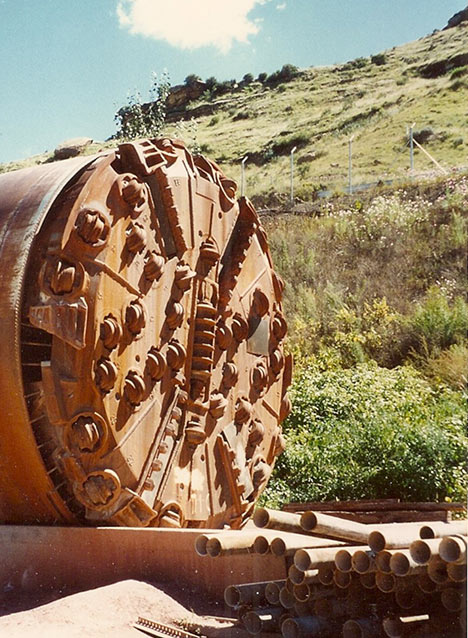The rumble of construction activity is set to be heard once again high in the mountains of Lesotho as elements of Phase II of the binational water delivery project between Lesotho and neighbouring South Africa are developed towards a construction start within the coming years.
Phase II builds on the successful completion of Phase IA in 1998 and 1B in 2003 and includes excavation of an approximately 38km long x 5m diameter tunnel to transfer water by gravity from the new reservoir Polihali on the Senqu River in the Mokhotlong district into the existing Phase I Katse reservoir for delivery to South Africa via the existing Phase I tunnelled and run-of-river transfer scheme. Along with the new transfer tunnel, Phase II includes a new 165m high concrete-faced rockfill dam and a new measurement weir on the Senqu River and a proposed lake-tap outlet into the Katse reservoir.
Phase II of the treaty-controlled delivery of water from the highlands of Lesotho to the Vaal Dam in South Africa is needed to increase current delivery of the Phase I scheme to meet increasing demand for potable water in the Gauteng region of South Africa that includes the cities of Johannesburg and Pretoria and the industrial powerhouses that they support. The transfer system also generates hydro-electricity for Lesotho.
Development of Phase II has been progressing since Phase I was completed, and in late 2017, the Lesotho Highlands Development Authority (LHDA), the implementing and management authority for the Project on behalf of the Government of Lesotho, awarded the contract for designing and supervising the construction of the Polihali water transfer tunnel - the largest of the Phase II engineering design contracts - to the Metsi a Senqu-Khubelu Consultants (MSKC) Joint Venture.
The Authority is also recruiting leading professionals to a Panel of Experts to advise LHDA on the design, construction and procurement of the major civil works of the Phase II project, including development of proposed additional hydroelectric potential within the new scheme and advice on construction and contract law for major civil engineering projects. Applications for the panel close on 19 March 2018 (see the Procurement Notice for more details).
Work by the MSKC JV on the approximately Maluti/Rand 900 million, Phase II Polihali transfer tunnel design and construction supervision contract – the largest of the Phase II engineering design contracts – began in December 2017. The MSKC team comprises Lesotho-based FM Associates, and South African firms Aurecon South Africa, Hatch Africa, Knight Piesold and SMEC South Africa. Sub-consultants include White Life Consultants of Lesotho; S5 Construction Consultants of Lesotho; and ILISO Consulting of South Africa
“The appointment is a significant Phase II milestone,” said Lesotho Minister of Water Samonyane Ntsekele MP. “The MSKC JV combines local, regional and international tunnel experts, well qualified to deliver on the brief, within the timeframe, and to the highest standards.”
The scope of services includes reviewing the existing project information and preparing the preliminary design of the transfer tunnel; preparing the tender design, drawings and tender documents for the construction of the tunnel; supporting LHDA through the contract tender and award process; and providing contract management services during the construction of the tunnel.
Specialists on the proposed Panel of Experts will advise and assist LHDA in the design and construction disciplines of major bridges, concrete faced rockfill dams, tunneling and tunnel structures for water and hydropower projects; geology and geotechnical engineering, mechanical and electrical engineering for water and hydropower projects, and construction and contract law.
The envisaged 38km long transfer tunnel will be designed to transfer water by gravity from from the Polihali reservoir into the Katse reservoir. Construction is expected to commence in 2020 and to be completed by the end of 2025. It is said that both TBM and drill+blast methods will be used to excavate the tunnel.
When completed by the 2025 due date, the elements of Phase II will progressively increase the current water supply rate per annum to South Africa from 780 million m3 to more than 1 270 million m3. At the same time, it will increase the quantity of electricity generated in Lesotho as a further step in securing a national independent electricity source.

The major works of Phase I included the construction of the Katse Dam, the water transfer and delivery tunnels, ‘Muela Dam and ‘Muela Hydropower Plant, the Masuko weir and delivery tunnel, and the Mohale Dam and transfer tunnel (Fig 1). The Phase II water transfer component comprises a dam at Polihali and a gravity tunnel that will connect the reservoir at Polihali with the Katse Reservoir. The envisaged hydropower component will comprise the Kobong Pumped Storage Scheme, or a similar scheme, subject to agreement on current joint final feasibility studies.
In building on the legacy of the Phase IA and IB elements of the project, Phase II will add approximately 38km of water transfer tunnelling to the 82km completed under the Phase IA project and the 38.4km of Phase IB elements comprising:
Phase IA
Transfer Tunnel: 45km x 5m diameter excavated by 3 TBMs
Delivery Tunnel South: 15km x 5m diameter by 1 TBM
Delivery Tunnel North: 22km x 5m diameter by 1 TBM
Phase IB
Matsoku Transfer Tunnel: 6.4km x 4.5m diameter by drill+blast
Mohale Interconnection Tunnel: 32km x 3.4m diameter x 2 TBMs
When completed by the 2025 due date, the elements of Phase II will progressively increase the current water supply rate per annum to South Africa from 780 million m3 to more than 1 270 million m3. At the same time, it will increase the quantity of electricity generated in Lesotho as a further step in securing a national independent electricity source.
|
|
|
|
|